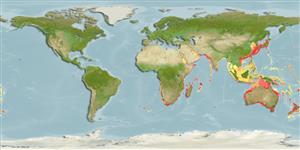分类 / Names
俗名 | 同种异名 | Catalog of Fishes(属, 种) | ITIS | CoL | WoRMS | Cloffa
Environment: milieu / climate zone / depth range / distribution range
生态学
海洋; 半咸淡水 居于水底的; 深度上下限 0 - 476 m (Ref. 5578), usually 0 - 200 m (Ref. 89422). 溫帶
Indo-West Pacific: antitropical; from southern Africa to New Zealand, and off Japan and Peter the Great Bay (eastern Russia).
印度-西太平洋: 莫三比克南部與南非 (參考文獻 5578) ,紐西蘭與溫帶與亞熱帶的澳洲海岸。 來自泰國的這種的報告可能是 松原魟〔Dasyatis matsubarai〕 的近親。
Length at first maturity / 大小 / 重量 / 年龄
Maturity: Lm ?, range 120 - ? cm
Max length : 430 cm TL 雄鱼/尚未辨别雌雄; (Ref. 5578); common length : 125 cm TL 雄鱼/尚未辨别雌雄; (Ref. 9258)
简单描述
型态特徵 | 形态测量图
背棘 (总数): 0; 背的软条 (总数): 0. This species is huge, plain-coloured, with a disc broad and rhombic, belly with transverse groove, tail short tapering strongly before caudal sting, thorns when present are confined to tail before sting, pectoral fin with an oblique rows of white spots dorsally; disc width ca. 1.1-1.2 times its length, very thick trunk; narrowly-rounded pectoral-fin apex; short snout, obtuse with tip barely extended and anterior margins weakly convex; small eyes with orbit length and spiracle 2.0-2.2 in snout length; broad interorbital space, up to 4 times orbit length in adults; mouth often with 5-7 oral papillae, deep labial furrows, weakly convex lower jaw; very broadly skirt-shaped nasal curtain, its margin fringed; oblique oval nostrils; smooth skin, no derml denticles, with specimens > 45 cm WD having a row of spear-shaped or starry-based thorns and tubercles on mid-line of tail before the caudal sting and the tail beyond this is covered with sharp thornlets; very broad tail depressed at the base, often shorter that width disc, often with one caudal sting, its ventral fold is short but prominent (extending to just beyond tip of sting), its dorsal fold reduced to a hard ridge; pelvic fins are rather small with narrowly-rounded apices. Colour of upper surface uniformly greyish brown and darkest on tail tip and above the eye; white inside of spiracles, pores around side of head and diagonal row of pores on each side of anterior disc; white ventrally; disc margin and undersurface of tail dusky (Ref. 114953).
一个极大的,厚的,和单色的 具有一个钝有角的吻,而且一个胸盘有圆的顶端; 尾部基底厚而短于身体 (更长的当幼鱼时) 具有一个小的上面与一个长的下尾部的鳍褶, 下面的不达到尾部顶端; 体盘平滑的在刺之前除了在尾部的大又细长的刺; 时常 2个刺, 一个在前面的小, 一个后面的极大.(参考文献 5578) 灰褐色或蓝灰色的背面在每个胸鳍基底具有一列小又蓝灰色斑点; 腹侧白色的; 尾部平原.(参考文献 5578) 尾鳍被一个长的鞭状尾部取代。 (参考文献 26346) 尾部短于或如同体盘一般的长度.(参考文献 26346)
Occurs offshore, on the outer shelf and uppermost slope; sometimes close inshore (Ref. 5578), in very shallow ( 0 m) depths (Ref. 26346). Found on sandy bottoms, in bays, harbors, and near rocky reefs (Ref. 12951). Often in aggregations (Ref. 12951). Feeds on fishes, bivalves, squid, and crustaceans (Ref. 12951). Ovoviviparous (Ref. 50449). Reputed to be the largest stingray in the world weighing more than 350,000 g (Ref. 6871). Frequently raises its tail in a scorpion-like fashion when approached, but is considered more as inquisitive rather than aggressive (Ref. 6871). The barbed tail however can inflict a severe or potentially fatal wound (Ref. 6871). Sometimes caught by anglers (Ref. 5578). It is parasitised by the monogenean Heterocotyle tokoloshei in the gills (Ref. 124053)
生存外海, 在外部的大陆架与最上面的斜坡上; 有时近岸.(参考文献 5578) 在海湾,港湾与邻近岩礁中, 栖息于砂质底部了。 (参考文献 12951) 常聚集成群。 (参考文献 12951) 吃鱼,二枚贝,乌贼与甲壳动物。 (参考文献 12951) 卵胎生的.(参考文献 50449) 相传是最大的 世界上秤重超过 350,000 g 。 (参考文献 6871) 时常在一个像蝎子一样当被接近时中举起它的尾部, 但是一般认为更多当好奇的而不是侵略性.(参考文献 6871) 有刺的尾部然而能施放严重或可能致命的创伤。 (参考文献 6871) 有时被垂钓者捕获了。 (参考文献 5578) 最小深度记录自了参考文献 26346.
Life cycle and mating behavior
成熟度 | 繁殖 | 产卵场 | 卵 | 孕卵数 | 仔鱼
Exhibit ovoviparity (aplacental viviparity), with embryos feeding initially on yolk, then receiving additional nourishment from the mother by indirect absorption of uterine fluid enriched with mucus, fat or protein through specialised structures (Ref. 50449). Distinct pairing with embrace (Ref. 205). During courtship, the male will hold onto the pectoral margin of a female (sometimes for hours) as she swims through the water. The male flips under the female and inserts a clasper. The male beats his tail from side to side to move the clasper backward and forward in the cloca. Copulation lasts 3-5 minutes. Males have been observed to nudge the female's abdomen during parturition. Viviparous, young born at about 36 cm WD (Ref. 6871).印度-西太平洋: 莫三比克南部與南非 (參考文獻 5578) ,紐西蘭與溫帶與亞熱帶的澳洲海岸。 來自泰國的這種的報告可能是 松原魟〔Dasyatis matsubarai〕 的近親。
Last, P.R., W.T. White, M.R. de Carvalho, B. Séret, M.F.W. Stehmann and G.J.P. Naylor, 2016. Rays of the world. CSIRO Publishing, Comstock Publishing Associates. i-ix + 1-790. (Ref. 114953)
人类利用
游钓鱼种: 是的; 水族馆: 商业性
更多信息
参考文献养殖养殖信息品种遗传学Electrophoreses遗传率疾病加工NutrientsMass conversion
工具
特别资料
下载 XML
网络资源
Estimates based on models
Preferred temperature (Ref.
123201): 14.6 - 28.5, mean 24.1 °C (based on 2002 cells).
Phylogenetic diversity index (Ref.
82804): PD
50 = 0.6250 [Uniqueness, from 0.5 = low to 2.0 = high].
Bayesian length-weight: a=0.00646 (0.00265 - 0.01571), b=3.06 (2.86 - 3.26), in cm total length, based on LWR estimates for this (Sub)family-body shape (Ref.
93245).
营养阶层 (Ref.
69278): 3.9 ±0.45 se; based on food items.
Fishing Vulnerability (Ref.
59153): Very high vulnerability (90 of 100).
Nutrients (Ref.
124155): Calcium = 2.46 [0.37, 44.68] mg/100g; Iron = 0.194 [0.018, 2.273] mg/100g; Protein = 21.3 [18.7, 24.0] %; Omega3 = 0.362 [0.114, 1.026] g/100g; Selenium = 21.7 [4.4, 114.2] μg/100g; VitaminA = 1.89 [0.16, 20.28] μg/100g; Zinc = 0.26 [0.02, 2.86] mg/100g (wet weight);
